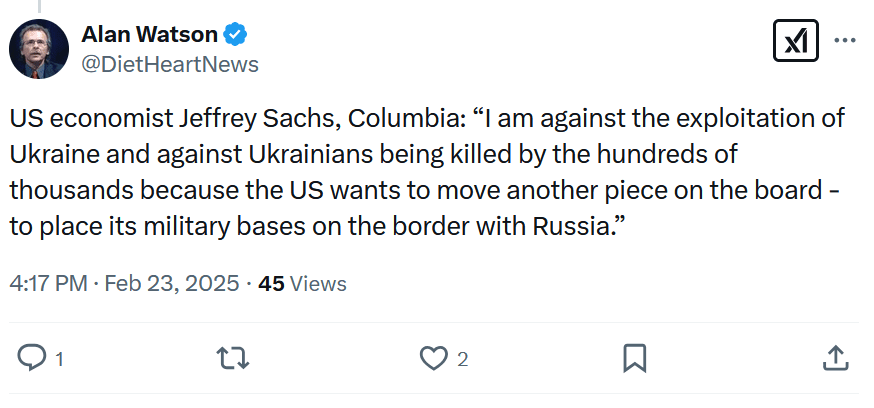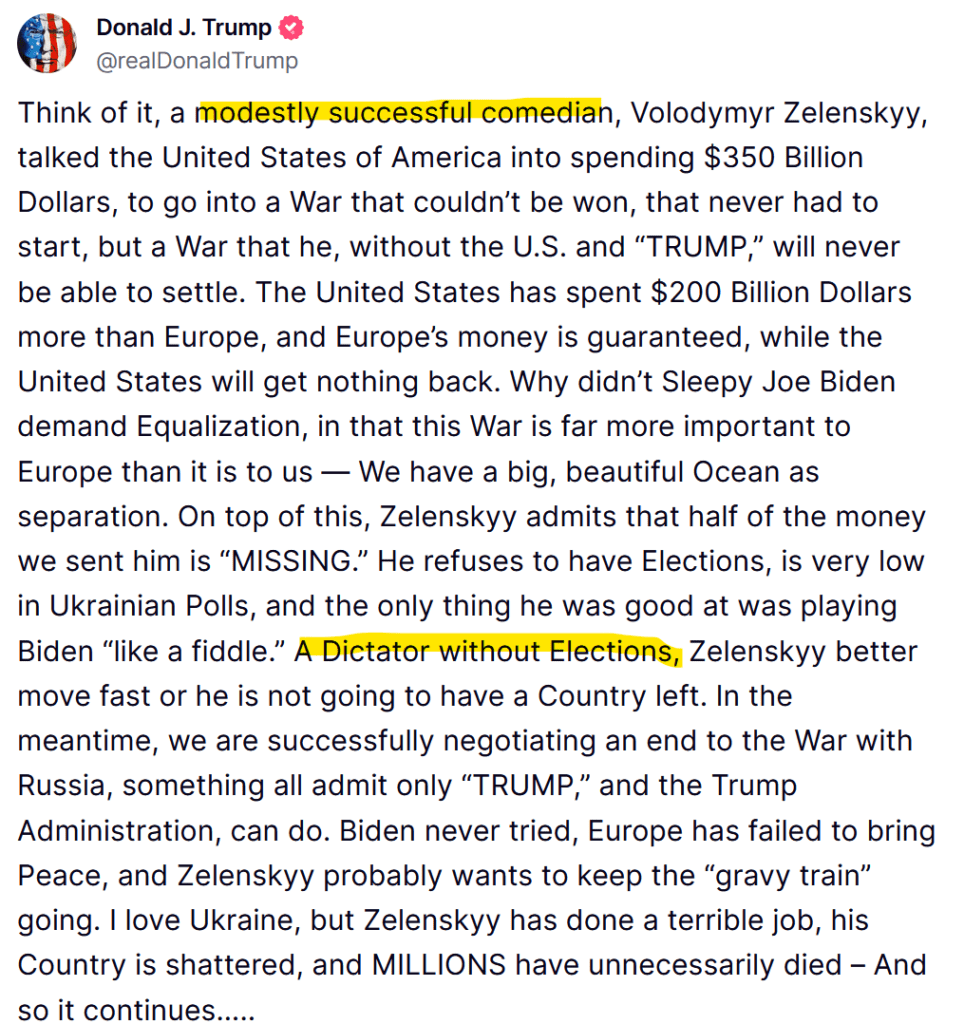For years, the mainstream media—cheerleaders for the Biden administration’s foreign policy—have peddled a simplistic tale: Vladimir Putin, the unhinged aggressor, launched an “unprovoked” war on Ukraine in February 2022, leaving the West no choice but to arm Kyiv to the teeth. This narrative, parroted relentlessly by outlets like The New York Times (which has used “unprovoked” no fewer than 26 times in its coverage), has shaped public perception into a black-and-white morality play.
But what if this is a lie by omission, a carefully curated distortion that obscures a deeper, messier truth? Enter Jeffrey Sachs (website)—economist, Columbia University professor, and a rare voice of dissent—who argues that the Ukraine war’s origins lie not in Moscow’s paranoia but in Washington’s provocations, particularly through NATO’s eastward creep. As a political analyst for The Cyber Voice, I’ll peel back the layers of this conflict, spotlight Sachs’ hypothesis, and expose how the media’s complicity has fueled a proxy war—with Ukraine as the sacrificial pawn.
The Sachs Hypothesis: NATO Expansion as the Spark
Sachs doesn’t mince words: “This is a war that never should have happened.” Far from an impulsive Russian land grab, he contends the conflict was ignited by decades of U.S.-led NATO expansion, a policy that deliberately poked the Russian bear until it lashed out. In his view, the critical flashpoint came with Ukraine’s flirtation with NATO membership—a red line for Moscow that the West knowingly crossed. Sachs points to broken promises from the 1990s, when U.S. and German leaders assured Soviet President Mikhail Gorbachev that NATO wouldn’t move “one inch eastward” after the Warsaw Pact dissolved. Yet, by the early 2000s, NATO had swallowed up former Soviet satellites, and by 2008, it dangled membership before Ukraine and Georgia—moves Sachs calls “reckless provocations.”
Fast forward to 2021: Ukrainian President Volodymyr Zelensky, emboldened by Biden’s unwavering support, doubled down on NATO aspirations. Sachs highlights Putin’s December 2021 draft treaty, which demanded a halt to NATO enlargement—a plea the Biden administration dismissed outright. On X, users like
@Glenn_Diesen(X account) echo Sachs, noting on February 13, 2025: “The 2014 coup in Ukraine that started a decade of war: – The US ambassador to Russia (and later CIA Director) William Burns warned in 2008 that pulling a divided Ukraine into the NATO orbit would trigger a civil war and Russia would reluctantly intervene militarily.” The implication? Zelensky didn’t just provoke Putin; he was a willing tool in a U.S. strategy to encircle Russia, with NATO as the battering ram.
Biden’s Gambit: Zelensky as Proxy, Putin as Prey
The mainstream media’s portrayal of Putin as the sole villain conveniently sidesteps Biden’s role as puppet master. Sachs argues that the U.S., under Biden, saw Ukraine as a geopolitical chess piece to weaken Russia. Billions in military aid—over $65 billion by 2025—poured into Kyiv, not to defend democracy but to bleed Moscow dry. The Biden administration’s refusal to negotiate with Putin in 2021, despite his overtures, underscores this agenda. Sachs told Mandiner in 2023: “Had Biden agreed NATO wouldn’t enlarge, this war wouldn’t have happened.” Instead, Biden doubled down, cheerleading Zelensky’s NATO dreams while the media spun it as righteous defiance.
This wasn’t about Ukraine’s sovereignty—it was about U.S. dominance. Sachs notes a near-miss peace deal in March 2022, brokered by Turkey, where Zelensky accepted neutrality. Mysteriously, it collapsed—Sachs suspects U.S. pressure, a claim bolstered by former UK PM Boris Johnson’s trip to Kyiv to nix the deal. On X,

@DietHeartNews recently posted (February 23, 2025): “Sachs: ‘I’m against Ukrainians being killed by the hundreds of thousands because the US wants military bases on Russia’s border.’” The media? Silent on this angle, preferring to lionize Zelensky as a wartime hero while burying the body count.
Media Manipulation: The Unprovoked Lie
The mainstream media’s complicity is breathtaking. Sachs has called out The New York Times and its ilk for their “parrot-like repetition” of the Biden line—Putin’s aggression as the alpha and omega of the war. This isn’t journalism; it’s propaganda. By framing Russia’s invasion as unprovoked, they erase decades of NATO provocation and Biden’s meddling.
This isn’t just bias—it’s a deliberate rewrite of history. Orwell warned, “Who controls the past controls the future,” and the Biden-era press has played gatekeeper, shielding the public from inconvenient truths. The result? A war prolonged, Ukraine ravaged, and Putin vilified while the U.S. hides its fingerprints.
Trump’s Pivot: Peace Without Pawns?
Enter Donald Trump, whose recent moves signal a tectonic shift. As of February 2025, Trump’s team is negotiating directly with Putin, sidelining Zelensky and Europe—a stark rebuke to Biden’s multilateral crusade. Reports from BBC and Washington Post detail Trump’s February 12 call with Putin, where he pushed for peace talks, followed by a tepid nod to Zelensky. Sachs sees this as a breakthrough: “The war ends when a U.S. president says to Putin, ‘NATO enlargement was a bad idea.’” On X, @wyattreed13 (February 13) dubbed it “prophetic,” suggesting Trump’s dealmaking could unravel the conflict Biden fueled.
But here’s the provocation: Trump’s plan freezes out Ukraine and Europe, treating them as bystanders in their own fate. Zelensky’s protests—“We won’t accept agreements without us”—ring hollow against Trump’s blunt logic: “You’ve had three years to end it; you didn’t.” The media, predictably, howls betrayal, but Sachs might argue it’s the first honest U.S. move in decades—acknowledging Russia’s security fears instead of stoking them.
The Cyber Voice Take: A War of Hubris
The Ukraine war isn’t Putin’s alone—it’s a monster born of U.S. arrogance, NATO’s overreach, and Zelensky’s NATO flirtation, all egged on by Biden’s war hawks. Sachs’ hypothesis lays bare the provocation: this was never unprovoked, but a slow-motion train wreck the West engineered. The mainstream media, lapdogs of power, sold us a fairy tale while Ukraine burned. Now, Trump’s gambit—however brash—might cut through the fog, bypassing the pawns to face the real players. On X, the sentiment is clear: the public’s waking up. Will the media? Don’t hold your breath—they’re too busy polishing Biden’s legacy to notice the blood on their hands.
Stay tuned to The Cyber Voice for unfiltered truth in a world of spin.










